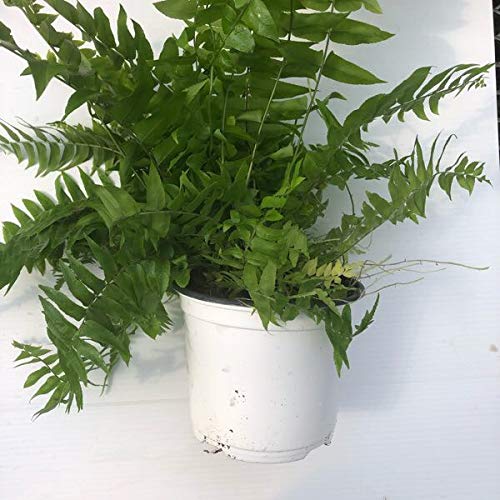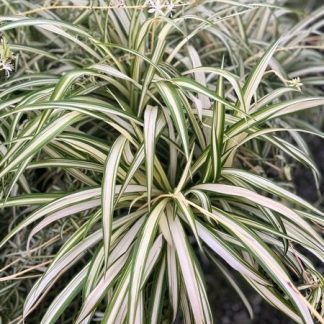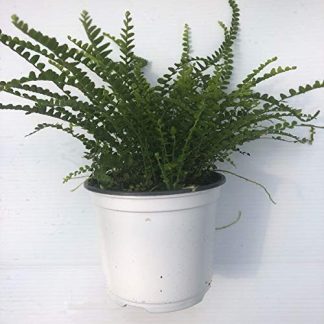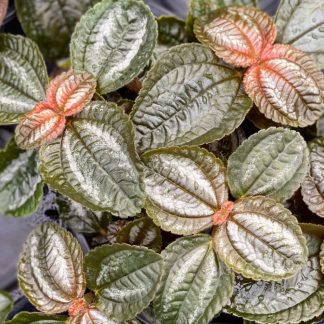Description
Macho Fern (Nephrolepis biserrata): The Giant Fern That Brings Lush Green Life to Any Space
Some plants have a quiet beauty. They blend into the background, adding soft texture and calm. But the Macho Fern (Nephrolepis biserrata) is different. This is a plant that demands attention in the best way possible. With fronds that can grow up to six feet long, it creates a dramatic, tropical presence wherever it grows.
This fern is perfect for those of us who love bold greenery but still want something easy to care for. It thrives both outdoors and indoors, in hanging baskets, large floor pots, or shady garden beds. Best of all, it offers that instant jungle-like feel without needing constant fussing or hard-to-find conditions.
Let’s explore why this giant fern is so special, how to grow it successfully, and the many ways it can enrich our gardens and homes.
A Closer Look at the Macho Fern
The Macho Fern is part of the sword fern family, closely related to the popular Boston Fern but much larger and bolder in scale. Its botanical name, Nephrolepis biserrata, gives a clue to its signature look. “Biserrata” means “twice-serrated,” referring to the finely toothed edges along each frond.
The fronds grow in an arching, fountain-like shape. Each leaflet is shiny, medium to deep green, and slightly leathery. Unlike many ferns, which can appear delicate or feathery, Macho Ferns have a more robust texture. This sturdiness makes them ideal for outdoor displays in shady spots, as they can handle wind and humidity far better than their daintier cousins.
Origins and Natural Habitat
Macho Ferns are native to tropical and subtropical regions. You can find them in parts of Florida, the Caribbean, Central America, and other warm, humid areas. In the wild, they grow in moist forests, often along stream banks or shaded woodland edges. Their preference for high humidity and indirect light reflects this natural setting.
When we bring them into our gardens or homes, they bring with them that same lush tropical energy. Whether used in a large container on a porch or as a floor plant inside, they capture the feeling of walking into a rainforest.
Why Choose Macho Fern?
There are many reasons gardeners and plant lovers choose this fern over others:
-
Impressive Size: Fronds can easily reach four to six feet long, creating a dramatic display.
-
Low Maintenance: They tolerate occasional neglect and bounce back quickly with water and shade.
-
Versatile Placement: Works beautifully indoors, on patios, or as a groundcover in shaded gardens.
-
Air Purification: Like other ferns, they help improve air quality by filtering toxins and adding humidity.
-
Non-Toxic: Safe for pets and children, making them ideal for family-friendly spaces.
In other words, Macho Ferns are both beautiful and practical. They give us that lush look we crave while asking for surprisingly little in return.
Ideal Growing Conditions
The secret to a thriving Macho Fern is recreating its tropical roots. That means consistent moisture, indirect light, and warmth. Let’s break down exactly what this fern needs.
Light
Macho Ferns prefer bright, indirect light. Outdoors, they thrive in partial to full shade. Indoors, place them near a north- or east-facing window, or a few feet back from a south-facing window where they get filtered sunlight.
Direct sun, especially during summer afternoons, can scorch the fronds. On the other hand, too little light can make the plant sparse and dull. Aim for that happy middle ground where the plant gets light but not harsh rays.
Temperature and Humidity
Warmth is key. This fern does best between 60°F and 80°F. It can handle brief drops into the 50s, but anything colder will cause stress and browning.
Humidity is equally important. While it can adapt to normal indoor humidity, Macho Ferns really thrive in high humidity environments. Bathrooms with windows, kitchens, or covered patios are perfect spots. In dry climates or winter months, misting the fronds or using a humidifier can keep them happy.
Soil
Use a rich, well-draining potting mix with organic matter. A peat-based mix with perlite or bark is ideal. Good drainage is essential—this fern loves moisture but not soggy roots.
Watering
Consistency is the secret. Keep the soil evenly moist, but not waterlogged. Water when the top inch of soil feels dry. In summer, this may mean watering several times per week, especially for outdoor containers. In winter, reduce frequency but never let the soil fully dry out.
Planting and Potting Tips
Because of its large size, Macho Fern is usually sold in big hanging baskets or large nursery pots. When planting:
-
Choose the right container. Use a pot at least 12 to 14 inches wide for young plants. For mature plants, even bigger is better to support root growth.
-
Check drainage. Always ensure your container has holes. Ferns dislike standing water.
-
Use fresh mix. Start with high-quality potting soil. Adding compost can boost nutrients.
-
Position carefully. Outdoors, place in shaded patios or under trees. Indoors, pick a bright but not sunny spot.
Repot every 2 to 3 years or when the plant outgrows its container. Spring is the best time for repotting, as the plant naturally enters its growth phase.
Outdoor Growing
Macho Ferns are hardy in USDA Zones 9 to 11. In these zones, they can be grown as perennials outdoors year-round. In cooler regions, treat them as annuals or bring them indoors for winter.
For outdoor beds:
-
Plant in dappled shade beneath trees or along shaded walkways.
-
Space plants generously. Their fronds can spread several feet across.
-
Mulch around the base to help retain soil moisture and keep roots cool.
Indoor Growing
When grown indoors, Macho Ferns make a bold statement in large floor pots. They add softness to corners and pair beautifully with other tropical plants like palms, monsteras, or calatheas.
Key indoor tips:
-
Keep away from heat vents or air conditioners.
-
Use a pebble tray or humidifier for extra moisture.
-
Rotate the pot occasionally to keep growth even on all sides.
Fertilizing for Growth
Macho Ferns are moderate feeders. During spring and summer, apply a balanced liquid fertilizer every 4 to 6 weeks at half strength. This supports strong frond growth and deep green color.
In fall and winter, stop fertilizing. The plant naturally slows its growth during cooler months.
Pruning and Grooming
Regular grooming keeps this fern looking its best. Remove any yellow or damaged fronds at the base to encourage new growth. This also improves airflow and reduces the risk of pests.
If your fern becomes leggy, you can trim it back in spring. New fronds will quickly replace the old, giving it a refreshed appearance.
Common Problems and Solutions
Even hardy plants like Macho Fern can face issues. Here are a few common ones and how to handle them:
-
Brown tips or edges: Usually caused by low humidity or inconsistent watering. Mist often or add a humidifier.
-
Yellowing fronds: Often a sign of overwatering or poor drainage. Check the soil and pot holes.
-
Sparse growth: Not enough light. Move closer to a window or brighter shaded spot outdoors.
-
Pests (spider mites, scale): Rare but possible. Wipe leaves with soapy water or use insecticidal soap.
Propagation
Macho Ferns are typically propagated by division. This is easiest when repotting in spring:
-
Remove the plant from its pot.
-
Gently separate clumps, ensuring each has roots attached.
-
Replant divisions into fresh soil.
-
Keep evenly moist and shaded until established.
Dividing every few years helps keep plants healthy and manageable.
Landscaping and Design Ideas
Macho Ferns are versatile and can transform any space into a tropical haven:
-
Front Porch Drama: Place in oversized hanging baskets for cascading greenery.
-
Shady Borders: Use them to line pathways or underplant large shade trees.
-
Poolside Retreat: Combine with palms and elephant ears for a lush, resort-like feel.
-
Indoor Statement Plant: Set in a ceramic pot in a living room corner for an instant focal point.
Their size and texture make them perfect companions for flowering shade plants like impatiens, begonias, or caladiums.
Seasonal Care
-
Spring: Repot, divide, and feed regularly as growth resumes.
-
Summer: Water and mist often. Protect from intense midday sun.
-
Fall: Reduce feeding. Clean up dead fronds. Prepare for indoor move if in cooler zones.
-
Winter: Keep warm and moist indoors. Watch for dry air from heating systems.
The Joy of Growing Macho Fern
Bringing a Macho Fern into your home or garden is like adding an instant piece of the tropics. Its lush fronds invite touch and attention. It softens hard edges, fills empty spaces, and makes every corner feel alive.
Most of all, this plant rewards even minimal care with maximum beauty. Once you find its happy spot—moist soil, high humidity, and filtered light—it will thrive for years, growing fuller and more impressive each season.
Bold Green Companions for Your Garden
The Macho Fern is more than just a plant. It’s a presence. Whether draping from a porch or anchoring a shady garden bed, it brings the wild, calming energy of nature closer to home. By understanding its needs and celebrating its natural drama, we can enjoy its beauty year after year.




